
A prisoner of war (POW) is a person who is held captive by a belligerent power during or immediately after an armed conflict. The earliest recorded usage of the phrase "prisoner of war" dates back to 1610.
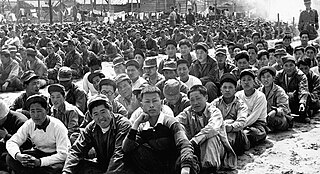
A prisoner-of-war camp is a site for the containment of enemy fighters captured as prisoners of war by a belligerent power in time of war.
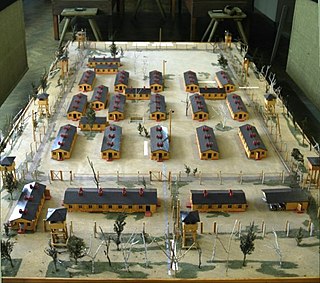
In Germany, stalag was a term used for prisoner-of-war camps. Stalag is a contraction of "Stammlager", itself short for Kriegsgefangenen-Mannschaftsstammlager, literally "main camp for enlisted prisoners of war". Therefore, "stalag" technically means "main camp".
Camp Albuquerque was an American World War II POW camp in Albuquerque, New Mexico that housed Italian and German prisoners of war. From this branch camp, the POWs did mostly farm labor, from 1943 to 1946. Most of these POWs were transferred from Camp Roswell, which was a base or main POW camp for New Mexico. Camp Lordsburg, New Mexico, and Camp El Paso, Texas, were also base camps.

Job Maseko was a South African soldier during World War II, serving in the Native Military Corps as part of the South African 2nd Infantry Division. He was one of many Allied troops captured by the Axis in the surrender of the port of Tobruk in 1942.

Stalag XI-B and Stalag XI-D / 357 were two German World War II prisoner-of-war camps (Stammlager) located just to the east of the town of Fallingbostel in Lower Saxony, in north-western Germany. The camps housed Polish, French, Belgian, Soviet, Italian, British, Yugoslav, American, Canadian, New Zealander and other Allied POWs.

Stalag VIII-A was a German World War II prisoner-of-war camp, located just to the south of the town of Görlitz in Lower Silesia, east of the River Neisse. The location of the camp lies in today's Polish town of Zgorzelec, which lies over the river from Görlitz.
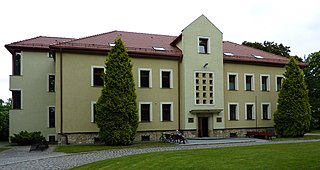
Łambinowicepronounced['wambinɔˈvit͡sɛ] is a village in Nysa County, Opole Voivodeship, in southern Poland. It is the seat of the gmina called Gmina Łambinowice. It lies approximately 17 kilometres (11 mi) north-east of Nysa and 31 km (19 mi) south-west of the regional capital Opole.

Stalag VIII-C was a German World War II prisoner-of-war camp, near Sagan, Lower Silesia. It was adjacent to the famous Stalag Luft III, and was built at the beginning of World War II, occupying 48 ha. It housed Allied POWs of various nationalities, incl. Polish, French, Belgian, British, Canadian, Greek, Yugoslav, Soviet, Australian, New Zealand, South African, Italian, Senegalese, Algerian, Moroccan and Slovak.

Stalag VII-A was the largest prisoner-of-war camp in Nazi Germany during World War II, located just north of the town of Moosburg in southern Bavaria. The camp covered an area of 35 hectares. It served also as a transit camp through which prisoners, including officers, were processed on their way to other camps. At some time during the war, prisoners from every nation fighting against Germany passed through it. At the time of its liberation on 29 April 1945, there were 76,248 prisoners in the main camp and 40,000 or more in Arbeitskommando working in factories, repairing railroads or on farms.

Camp Fünfeichen was a World War II German prisoner-of-war camp located in Fünfeichen, a former estate within the city limits of Neubrandenburg, Mecklenburg, northern Germany. Built as Stalag II-A Neubrandenburg in 1939, it was extended by the officer camp Oflag II-E in 1940. After the Soviet takeover in 1945 until 1949 it was used as special camp, NKVD-camp Nr. 9 of the Soviet secret service (NKVD). Today, the site of the camp is a memorial.
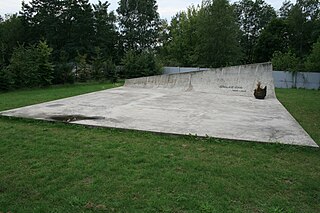
Stalag XI-A was a German World War II prisoner-of-war camp (Stammlager), located just to the east of the village of Altengrabow and in the south of Dörnitz in Saxony-Anhalt, about 90 km (56 mi) south-west of Berlin.

Hendrik Frederik Prinsloo, OBE, ED was a South African army officer. As a 12-year-old boy, he was interned by the British in a concentration camp during the Anglo-Boer War but served alongside the British in the South African forces during the two World Wars. He is best remembered for the humanitarian manner in which he, as commandant, ran the Zonderwater Italian prisoner of war camp.
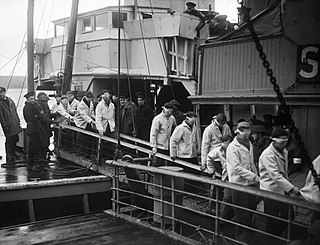
Large numbers of German prisoners of war were held in Britain between the outbreak of the Second World War in September 1939 and late 1948. Their numbers reached a peak of around 400,000 in 1946, and then began to fall when repatriation began. The experiences of these prisoners differed in certain important respects from those of captured German servicemen held by other nations. The treatment of the captives, though strict, was generally humane, and fewer prisoners died in British captivity than in other countries. The British government also introduced a programme of re-education, which was intended to demonstrate to the POWs the evils of the Nazi regime, while promoting the advantages of democracy. Some 25,000 German prisoners remained in the United Kingdom voluntarily after being released from prisoner of war status.
Italian prisoners of war in Australia were Italian soldiers captured by the British and Allied Forces in World War II and taken to Australia.
The Italian Service Units or ISUs were military units composed of Italian prisoners of war (POWs) that served with the Allies during World War II against Nazi Germany and the Empire of Japan from May 1944 to October 1945. The armed forces of the United States captured many Italian soldiers during the North African campaign Operation Torch, which started in November 1942 and sent 51,000 of them to the United States. After the signing of the armistice by the Badoglio government in Italy on September 8, 1943, and with Pietro Badoglio and the Kingdom of the South officially declaring war on Nazi Germany on October 13, 1943, the Americans began to see the POWs as potential allies. The capture of Rome by the Allies on June 4, 1944, motivated many POWs to change sides. About 90% joined Italian Service Units, which operated in the United States and overseas.

The Ascent is a 1994 American war adventure film directed by Donald Shebib. The film is an adaptation of a memoir by a then Italian prisoner of war in 1942 British East Africa who challenges his English captor in a climb of Mount Kenya.
Aldo Manos is an Italian diplomat, professor and author. He is the founding members of the United Nations office located in Kenya.














